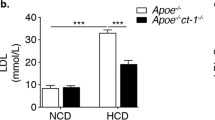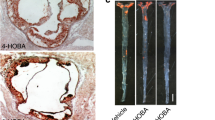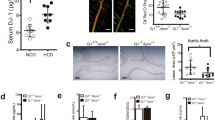Abstract
Oxidized phospholipids (OxPL) are ubiquitous, are formed in many inflammatory tissues, including atherosclerotic lesions, and frequently mediate proinflammatory changes1. Because OxPL are mostly the products of non-enzymatic lipid peroxidation, mechanisms to specifically neutralize them are unavailable and their roles in vivo are largely unknown. We previously cloned the IgM natural antibody E06, which binds to the phosphocholine headgroup of OxPL, and blocks the uptake of oxidized low-density lipoprotein (OxLDL) by macrophages and inhibits the proinflammatory properties of OxPL2,3,4. Here, to determine the role of OxPL in vivo in the context of atherogenesis, we generated transgenic mice in the Ldlr−/− background that expressed a single-chain variable fragment of E06 (E06-scFv) using the Apoe promoter. E06-scFv was secreted into the plasma from the liver and macrophages, and achieved sufficient plasma levels to inhibit in vivo macrophage uptake of OxLDL and to prevent OxPL-induced inflammatory signalling. Compared to Ldlr−/− mice, Ldlr−/−E06-scFv mice had 57–28% less atherosclerosis after 4, 7 and even 12 months of 1% high-cholesterol diet. Echocardiographic and histologic evaluation of the aortic valves demonstrated that E06-scFv ameliorated the development of aortic valve gradients and decreased aortic valve calcification. Both cholesterol accumulation and in vivo uptake of OxLDL were decreased in peritoneal macrophages, and both peritoneal and aortic macrophages had a decreased inflammatory phenotype. Serum amyloid A was decreased by 32%, indicating decreased systemic inflammation, and hepatic steatosis and inflammation were also decreased. Finally, the E06-scFv prolonged life as measured over 15 months. Because the E06-scFv lacks the functional effects of an intact antibody other than the ability to bind OxPL and inhibit OxLDL uptake in macrophages, these data support a major proatherogenic role of OxLDL and demonstrate that OxPL are proinflammatory and proatherogenic, which E06 counteracts in vivo. These studies suggest that therapies inactivating OxPL may be beneficial for reducing generalized inflammation, including the progression of atherosclerosis, aortic stenosis and hepatic steatosis.
This is a preview of subscription content, access via your institution
Access options
Access Nature and 54 other Nature Portfolio journals
Get Nature+, our best-value online-access subscription
$29.99 / 30 days
cancel any time
Subscribe to this journal
Receive 51 print issues and online access
$199.00 per year
only $3.90 per issue
Buy this article
- Purchase on Springer Link
- Instant access to full article PDF
Prices may be subject to local taxes which are calculated during checkout




Similar content being viewed by others
Change history
16 July 2018
In this Letter, affiliation number 1 was originally missing from the HTML; the affiliations were missing for author Ming-Yow Hung in the HTML; and the Fig. 4 legend erroneously referred to panels a–h, instead of a–g. These errors have been corrected online.
References
Binder, C. J., Papac-Milicevic, N. & Witztum, J. L. Innate sensing of oxidation-specific epitopes in health and disease. Nat. Rev. Immunol. 16, 485–497 (2016).
Shaw, P. X. et al. Natural antibodies with the T15 idiotype may act in atherosclerosis, apoptotic clearance, and protective immunity. J. Clin. Invest. 105, 1731–1740 (2000).
Friedman, P., Horkko, S., Steinberg, D., Witztum, J. L. & Dennis, E. A. Correlation of antiphospholipid antibody recognition with the structure of synthetic oxidized phospholipids. importance of Schiff base formation and aldol condensation. J. Biol. Chem. 277, 7010–7020 (2002).
Chang, M. K. et al. Apoptotic cells with oxidation-specific epitopes are immunogenic and proinflammatory. J. Exp. Med. 200, 1359–1370 (2004).
Miller, Y. I. et al. Oxidation-specific epitopes are danger-associated molecular patterns recognized by pattern recognition receptors of innate immunity. Circ. Res. 108, 235–248 (2011).
Tsiantoulas, D. et al. Circulating microparticles carry oxidation-specific epitopes and are recognized by natural IgM antibodies. J. Lipid Res. 56, 440–448 (2015).
Lee, S. et al. Role of phospholipid oxidation products in atherosclerosis. Circ. Res. 111, 778–799 (2012).
Imai, Y. et al. Identification of oxidative stress and Toll-like receptor 4 signaling as a key pathway of acute lung injury. Cell 133, 235–249 (2008).
Baldan, A. et al. ABCG1 is required for pulmonary B-1 B cell and natural antibody homeostasis. J. Immunol. 193, 5637–5648 (2014).
Haider, L. et al. Oxidative damage in multiple sclerosis lesions. Brain 134, 1914–1924 (2011).
Liu, B. et al. Oxidized phospholipid oxPAPC activates TRPA1 and contributes to chronic inflammatory pain in mice. PLoS ONE 11, e0165200 (2016).
Oehler, B. et al. Inflammatory pain control by blocking oxidized phospholipid-mediated TRP channel activation. Sci. Rep. 7, 5447 (2017).
Ikura, Y. et al. Localization of oxidized phosphatidylcholine in nonalcoholic fatty liver disease: impact on disease progression. Hepatology 43, 506–514 (2006).
Tsimikas, S. A test in context: lipoprotein(a): diagnosis, prognosis, controversies, and emerging therapies. J. Am. Coll. Cardiol. 69, 692–711 (2017).
Turner, W. W. et al. Design and synthesis of a stable oxidized phospholipid mimic with specific binding recognition for macrophage scavenger receptors. J. Med. Chem. 55, 8178–8182 (2012).
Seimon, T. A. et al. Atherogenic lipids and lipoproteins trigger CD36–TLR2-dependent apoptosis in macrophages undergoing endoplasmic reticulum stress. Cell Metab. 12, 467–482 (2010).
Laffitte, B. A. et al. LXRs control lipid-inducible expression of the apolipoprotein E gene in macrophages and adipocytes. Proc. Natl Acad. Sci. USA 98, 507–512 (2001).
Spann, N. J. et al. Regulated accumulation of desmosterol integrates macrophage lipid metabolism and inflammatory responses. Cell 151, 138–152 (2012).
Kamstrup, P. R., Hung, M.-Y., Witztum, J. L., Tsimikas, S. & Nordestgaard, B. G. Oxidized phospholipids and risk of calcific aortic valve disease: the Copenhagen general population study. Arterioscler. Thromb. Vasc. Biol. 37, 1570–1578 (2017).
Houben, T. et al. Blood-derived macrophages prone to accumulate lysosomal lipids trigger OxLDL-dependent murine hepatic inflammation. Sci. Rep. 7, 12550 (2017).
Lewis, K. E. et al. Increase in serum amyloid a evoked by dietary cholesterol is associated with increased atherosclerosis in mice. Circulation 110, 540–545 (2004).
Popat, R. J. et al. Anti-myeloperoxidase antibodies attenuate the monocyte response to LPS and shape macrophage development. JCI Insight 2, e87379 (2017).
Zanoni, I., Tan, Y., Di Gioia, M., Springstead, J. R. & Kagan, J. C. By capturing inflammatory lipids released from dying cells, the receptor CD14 induces inflammasome-dependent phagocyte hyperactivation. Immunity 47, 697–709 (2017).
Podrez, E. A. et al. Identification of a novel family of oxidized phospholipids that serve as ligands for the macrophage scavenger receptor CD36. J. Biol. Chem. 277, 38503–38516 (2002).
Kadl, A. et al. Oxidized phospholipid-induced inflammation is mediated by Toll-like receptor 2. Free Radic. Biol. Med. 51, 1903–1909 (2011).
Towler, D. A. Molecular and cellular aspects of calcific aortic valve disease. Circ. Res. 113, 198–208 (2013).
Ambrogini, E. et al. Oxidation-specific epitopes restrain bone formation. Nat. Commun. https://doi.org/10.1038/s41467-018-04047-5 (2018).
Briley-Saebo, K., Yeang, C., Witztum, J. L. & Tsimikas, S. Imaging of oxidation-specific epitopes with targeted nanoparticles to detect high-risk atherosclerotic lesions: progress and future directions. J. Cardiovasc. Transl. Res. 7, 719–736 (2014).
Tsimikas, S. et al. Human oxidation-specific antibodies reduce foam cell formation and atherosclerosis progression. J. Am. Coll. Cardiol. 58, 1715–1727 (2011).
Senders, M. L. et al. PET/MR imaging of malondialdehyde-acetaldehyde epitopes with a human antibody detects clinically relevant atherothrombosis. J. Am. Coll. Cardiol. 71, 321–335 (2018).
Gonen, A. et al. Atheroprotective immunization with malondialdehyde-modified LDL is hapten specific and dependent on advanced MDA adducts: implications for development of an atheroprotective vaccine. J. Lipid Res. 55, 2137–2155 (2014).
Chou, M. Y. et al. Oxidation-specific epitopes are dominant targets of innate natural antibodies in mice and humans. J. Clin. Invest. 119, 1335–1349 (2009).
Schneider, M. et al. High-level lipoprotein [a] expression in transgenic mice: evidence for oxidized phospholipids in lipoprotein [a] but not in low density lipoproteins. J. Lipid Res. 46, 769–778 (2005).
Montano, E. N. et al. Development and application of a nonradioactive binding assay of oxidized low-density lipoprotein to macrophage scavenger receptors. J. Lipid Res. 54, 3206–3214 (2013).
Binder, C. J. et al. IL-5 links adaptive and natural immunity specific for epitopes of oxidized LDL and protects from atherosclerosis. J. Clin. Invest. 114, 427–437 (2004).
Cowling, R. T. et al. Discoidin domain receptor 2 germline gene deletion leads to altered heart structure and function in the mouse. Am. J. Physiol. Heart Circ. Physiol. 307, H773–H781 (2014).
Butcher, M. J., Herre, M., Ley, K. & Galkina, E. Flow cytometry analysis of immune cells within murine aortas. J. Vis. Exp. 53, e2848 (2011).
Nowyhed, H. N. et al. The nuclear receptor Nr4a1 controls CD8 T cell development through transcriptional suppression of Runx3. Sci. Rep. 5, 9059 (2015).
Choi, S. H. et al. Lipoprotein accumulation in macrophages via Toll-like receptor-4-dependent fluid phase uptake. Circ. Res. 104, 1355–1363 (2009).
Acknowledgements
This work was supported by NIH Grants: HL088093 (X.Q., S.T., C.K.G., K.L., Y.I.M. and J.L.W.), HL086559 (J.L.W.), HL119828 (J.L.W. and S.T.), HL055798 (S.T., J.L.W., Y.I.M., K.L. and C.C.H.), HL136275 (S.T., J.L.W. and Y.I.M.), R35 HL135737 (J.L.W. andY.I.M.), HL055798 and HL112276 (C.C.H.), HL20948 (J.G.M.), DRC P30 DK063491 (P.L.M.), P42 ES010337 (P.L.M.), P30 CA23100 (P.L.M.), Center for Human Nutrition grant 550015400 (J.G.M.) and Leducq Foundation Transatlantic Grants to J.L.W. and C.K.G. X.Q. was supported in part by a Grant-in-Aid from American Heart Association and D.E.G. was supported in part by an American Heart Association post-doctoral grant (13POST16990031).
Reviewer information
Nature thanks N. Leitinger, A. R. Tall and the other anonymous reviewer(s) for their contribution to the peer review of this work.
Author information
Authors and Affiliations
Contributions
X.Q., S.T. and J.L.W. designed the project; X.Q., A.G., T.A.P., X.S., C.D., A.M., D.E.G., K.B., J.P. and J.G.M. conducted key experiments; P.L.M., C.C.H., K.L., K.L.P. and C.K.G. provided vital technical expertise and advice; M-Y.H., C.Y., K.L.P. and S.T. conducted aortic valve studies; X.Q. and J.L.W. wrote the manuscript with expert input from C.K.G., Y.I.M., S.Y-H., C.J.B., S.T. and all other coauthors.
Corresponding author
Ethics declarations
Competing interests
X.Q., S.T. and J.L.W. are co-inventors and receive royalties from patents owned by the University of California San Diego on the use of oxidation-specific antibodies. S.T. currently has a dual appointment at UCSD and as an employee of Ionis Pharmaceuticals. J.L.W. is a consultant to Ionis Pharmaceuticals.
Additional information
Publisher’s note: Springer Nature remains neutral with regard to jurisdictional claims in published maps and institutional affiliations.
Extended data figures and tables
Extended Data Fig. 1 E06-scFv expression and binding characteristics.
a, Simply blue staining of purified E06-scFv from HEK293 cell lysates from two experiments. b, Western blot with anti-Myc antibody of E06-scFv following purification on Ni-NTA agarose beads (representative of four independent experiments). c, Binding profile of purified E06-scFv using chemiluminescent ELISA. Binding data are mean ± s.e.m., using three independent samples, each determined in triplicate. d, Tissue distribution of the E06-scFv gene transcript in Ldlr−/−E06-scFv mice determined by qPCR. Data are mean ± s.e.m., determined from tissues of three Ldlr−/−E06-scFv mice. e, Competition immunoassays of Ldlr−/−E06-scFv plasma binding to plated OxLDL in the presence or absence of increasing amounts of indicated competitors. Results are the ratios of E06-scFv binding to OxLDL in the presence (B) or absence of a competitor (B0). AB1-2 is a T15 anti-idiotypic antibody; C16lysoPC, C16 lysophosphatidylcholine; DPPC, dipalmitoyl phosphatidylcholine. Data are triplicates of each point from one competition experiment, representative of four separate studies of similar nature. f, Accumulation of desmosterol and other indicated sterols in TGEM from indicated mice fed a HCD for 16 weeks. TGEM were isolated from three mice in each group and each set of macrophages divided into two separate aliquots for analysis in triplicate. Data are mean ± s.e.m. There were no differences between respective sterol pairs, P > 0.05 for all pairs.
Extended Data Fig. 2 Expressed E06-scFv does not alter the levels of total IgM or IgM–E06 (detected by AB1-2) in transgenic mice.
Comparison of plasma IgM titres to indicated antigens of Ldlr−/−or Ldlr−/−E06-scFv mice at baseline or after four or seven months of HCD. Note significant increases in total IgM and IgMs against MDA-LDL and OxLDL at four and seven months compared to respective baseline titres (all values, P < 0.001) except at four months, at which time the total IgM of Ldlr−/−E06-scFv mice and E06 (detected by AB1-2) in both mouse groups were not different from their respective baselines (P > 0.05). Notably, there were no significant differences in any antibody titres between Ldlr−/− or Ldlr−/−E06-scFv mice at any time point, and in particular, note that endogenous IgM–E06 titres (detected by AB1-2 binding) were similar. As expected, the plasma from Rag1−/− and Rag−/−E06-scFv mice did not have any IgM.
Extended Data Fig. 3 Plasma E06-scFv binds to atherosclerotic lesions and apoptotic thymocytes and is present in the aorta of Ldlr−/−E06-scFv mice.
a, Staining of atherosclerotic lesions of Watanabe heritable hyperlipidaemic (WHHL) rabbit aortas with E06-scFv plasma (left) and plasma from Ldlr−/− mice (right) (both at dilution of 1:20), visualized using a biotinylated anti-Myc monoclonal antibody and ABC-AP VectaStain kit. b, Deconvolution microscopy of E06-scFv plasma (1:20 dilution) binding to apoptotic but not normal cells. Blue, nuclei stained with Hoechst; green, FITC-labelled anti-His6-tag monoclonal antibody; red, annexin V–PE. c, Binding of E06-scFv plasma (1:20 dilution) to apoptotic thymocytes (7AAD+annexin V+) isolated by FACS analysis. d, Expression of E06-scFv in aortic lesion of a Ldlr−/−E06-scFv but not a Ldlr−/− mouse. Cross-sections at the aortic valve were stained with biotinylated anti-Myc monoclonal antibody to identify presence of E06-scFv in atherosclerotic lesion. Nuclei counterstained using haematoxylin QS (Original ×200). a–c, Representative of similar studies with five other plasma samples from each genotype. d, Representative of studies in three other aortic sections of each genotype.
Extended Data Fig. 4 Lipoprotein profiles of Ldlr−/− and Ldlr−/−E06-scFv mice are similar in various studies.
a, b, Distributions of plasma cholesterol (a) and triglycerides (b) by fast performance liquid chromatography in pools of equal aliquots of plasma from mice fed a HCD for 4 months (Ldlr−/− n = 10, Ldlr−/−E06-scFv n = 11). c, Plasma cholesterol distribution in mice fed a HCD for 7 months (Ldlr−/− n = 9, Ldlr−/−E06-scFv n = 7). d, Plasma cholesterol and triglyceride distribution in BMT experiment: lipoprotein profiles in Ldlr−/− mice that received bone marrow from wild-type (control, n = 9) or E06-scFv (n = 13) mice and tjat were then fed a Western diet for 16 weeks.
Extended Data Fig. 5 E06-scFv reduces necrotic core formation and macrophage secretion of E06-scFv confers atheroprotection.
a, E06-scFv reduces extent of necrosis within aortic root lesions after a HCD for seven months as shown in Fig. 2c. Lesions of equal size were matched at each of the indicated sites in aortic root sections from 7 Ldlr−/− and 9 Ldlr−/−E06-scFv mice and the extent of necrosis was measured as described in the Methods. Necrosis was reduced by 43.9% in Ldlr−/−E06-scFv mice (AUC 113.4 versus 63.6, P = 0.015). b, Secretion of E06-scFv in cultured peritoneal macrophages in the absence or presence of LXR agonist T090137 from C57BL/6 (wild-type) and E06-scFv mice determined by phosphocholine-binding assay. Culture supernatants were concentrated tenfold for ELISA (left). E06-scFv expression, driven by the Apoe promoter was stimulated by T0901317 as indicated by western blots of cell lysates with anti-Myc monoclonal antibody (right). Representative of four separate experiments. c, Plasma E06-scFv titres following transplantation (baseline) in Ldlr−/− mice transplanted with wild-type (n = 7) or E06-scFv (n = 7) bone marrow. E06-scFv titres (plasma from n = 7 wild-type and 7 E06-scFv mice) increased in mice transplanted with E06-scFv bone marrow over 16 weeks of Western diet. d, Aortic root atherosclerosis in Ldlr−/− mice transplanted with wild-type (n = 9) or E06-scFv (n = 13) bone marrow after 16 weeks of Western diet. As described in the Methods, aortic root lesion areas were quantified from serial sections (nine sections per mouse) cut through the aorta at the origins of the aortic valve leaflets and then stained with a modified van Geison solution. Lesions at aortic root were reduced by 37% in mice that received BMT from E06-scFv mice (AUC 69.6 versus 110.6, P = 0.02, two-sided t-test).
Extended Data Fig. 6 Aortic valve echocardiography and hepatic gene expression.
a, Representative pulse-wave Doppler-derived aortic jet velocities of a 12-month-old Ldlr−/−E06-scFv (left) and Ldlr−/− (right) mouse: ECG traces are shown in green. Representative of studies in n = 9 Ldlr−/− and 10 Ldlr−/−E06-scFv mice. b, Representative M-mode echocardiography images containing the aortic valves in the short axis through the right ventricular outflow tract (RVOT), aortic (Ao) root with aortic valve, and left atrium (LA). The aortic valve (arrows), best observed in diastole, is thinner in Ldlr−/−E06-scFv compared to Ldlr−/− mice. ECG traces shown in green. Representative of studies in n = 9 Ldlr−/− and 10 Ldlr−/−E06-scFv mice. c, Decreased inflammatory gene expression in whole-liver extracts of Ldlr−/− and Ldlr−/−E06-scFv mice after 16 weeks of HCD. Relative mRNA levels were determined by qPCR and normalized to Gapdh and expressed as mean ± s.e.m. n = 4 mice per group.
Supplementary information
Supplementary Information
A description of the E06 antibody is provided for the interested reader to provide the historical importance of this antibody, role in innate immunity and its binding characteristics with detailed descriptions of the epitope it binds. These details should assist the reader in proper interpretation of the E06-scFv role in these studies in neutralizing phosphocholine containing oxidized phospholipids. Relevant references are provided for the interested reader. The file also contains Supplementary Table 1, which provides a detailed description of the various labelled antibodies used in the FACS characterization of isolated arterial wall cells as described in Methods
Rights and permissions
About this article
Cite this article
Que, X., Hung, MY., Yeang, C. et al. Oxidized phospholipids are proinflammatory and proatherogenic in hypercholesterolaemic mice. Nature 558, 301–306 (2018). https://doi.org/10.1038/s41586-018-0198-8
Received:
Accepted:
Published:
Issue Date:
DOI: https://doi.org/10.1038/s41586-018-0198-8
This article is cited by
-
LXR agonism for CNS diseases: promises and challenges
Journal of Neuroinflammation (2024)
-
Breaking tolerance: the autoimmune aspect of atherosclerosis
Nature Reviews Immunology (2024)
-
Oxidized phospholipids during microbial challenge: friend or foe?
Genes & Immunity (2024)
-
Oxidized phospholipids in cardiovascular disease
Nature Reviews Cardiology (2024)
-
Kupffer cells dictate hepatic responses to the atherogenic dyslipidemic insult
Nature Cardiovascular Research (2024)
Comments
By submitting a comment you agree to abide by our Terms and Community Guidelines. If you find something abusive or that does not comply with our terms or guidelines please flag it as inappropriate.



